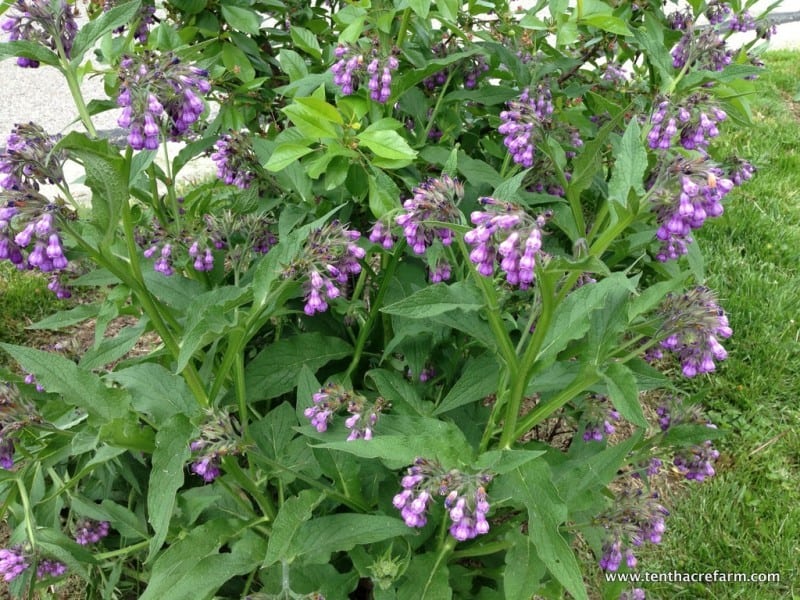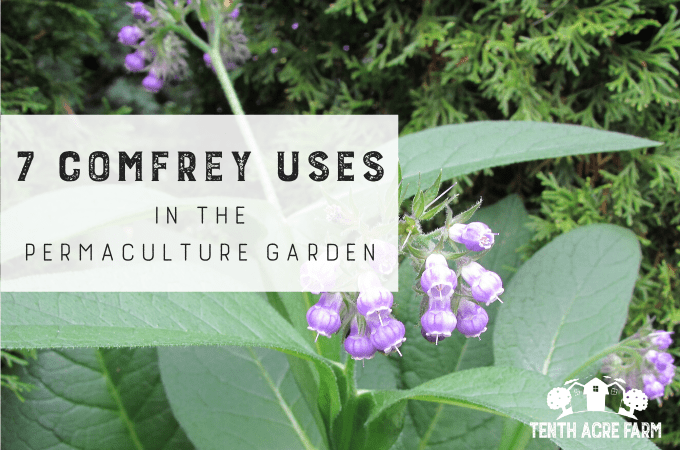7 Comfrey Uses in the Permaculture Garden
Comfrey fertilizer is considered a powerhouse in the permaculture garden. Here are seven comfrey uses for building healthy soil and growing healthy crops.


This page may contain affiliate links. Please read my disclosure for more info.
Comfrey: The Permaculture Star
If permaculture design had a poster child, it would be comfrey! It is a multi-functional, prolific, and low-maintenance herb—all the things we look for when selecting plants for the permaculture garden.
Among comfrey’s many attributes are its beautiful purple flowers that attract pollinators and other beneficial insects. Meanwhile, the large leaves shade the soil and provide habitat for beneficial insects.
It is also one of the most potent and effective medicinal herbs. Learn more about comfrey’s medicinal benefits in my article about how to make herbal salve.
What’s more, comfrey is known for enriching soil and accelerating soil-building.
7 Comfrey Uses in the Garden
If you’re wondering how to use comfrey in the garden, here are seven ways to take advantage of its ability to enrich and condition the soil.
1: Activate Compost
This is the most versatile of all the comfrey uses I mention in this article. Activating a compost pile allows you to more quickly make a rich and balanced soil amendment, which can then be used anywhere organic matter is needed.
In fact, because grass clippings and other compost ingredients can be contaminated with herbicides (even if you don’t spray), this prolific green matter is important for home composters.
Comfrey cuttings make an excellent bioactivator in the compost bin. If you have a large amount of dried brown material—such as fall leaves—layering it with comfrey cuttings is an efficient way to balance out the carbon-to-nitrogen ratio and jumpstart decomposition.
To give the compost pile an immediate kick into high gear, collect comfrey leaves and crush them. I like to use garden scissors to quickly cut through the leaves roughly. Add a small amount of water and stir/crush for a minute or two.
Add more water to liquefy, then pour the entire solution onto the compost pile. This quick little extra step is the equivalent of chewing food. The pre-digestion helps beneficial microorganisms of the compost pile (like those of our stomachs) work faster.
The finished compost will have a higher nutrient content with the addition of comfrey fertilizer.
Would you like to grow food in your front yard without sacrificing curb appeal? Check out my mini guide, The Permaculture Inspired Edible Landscape.


Comfrey cuttings are ready to be used as green manure, green mulch, or crushed and added to the compost bin.
2: Comfrey Green Manure
Green manure is an alternative to—or supplement to—animal manures as a soil amendment. Green manure plants are simply cut back and turned into the soil.
For those on city lots who may not have easy access to livestock manures, green manures are the way to go. In fact, out of all the comfrey uses in the garden, this is by far the simplest.
Manure sources are rated for their NPK values (Nitrogen-Phosphorus-Potassium) since these are the primary nutrients that plants need for healthy growth.
Compared to animal manures, comfrey values of NPK are relatively low. However, its nutrients are more immediately bioavailable to plants. Whereas animal manures can burn plants if added during the growing season, comfrey green manure can be applied at any time.
When using comfrey as a green manure, add chopped comfrey to garden soil in the fall. Gently mix it into the top layers of the soil using a digging fork. By spring, it will have decomposed and enriched the soil.


Comfrey cuttings and compost soil are added to beds in the fall as a green manure soil amendment.
Alternatively, comfrey manure can be added in the early spring—at least two weeks before planting. To jumpstart the decomposition of the comfrey manure at this late date, try the quick method explained above under Activate Compost.
Note: Comfrey plants may not emerge from their winter slumber until late March/early April depending on your location, so there may not be comfrey leaves to chop and spread before the growing season gets underway.
To counteract this potential problem, see the next step!
3: Powdered Comfrey in the Garden (The Best-Kept Secret of all the Comfrey Uses!)
Having dried comfrey on hand is a habit that I’ve grown accustomed to. Dried and powdered (root or leaf) comfrey can also be used to build and fertilize garden soil.
Make your own by air drying comfrey or by using a dehydrator (here’s mine) at 95 degrees until crisp. Remove the dried leaves from the stems and use a blender or coffee grinder to make a leaf powder. Store in an air-tight container.
Simply mix powdered comfrey into the soil with a digging fork, about two weeks before planting. Remember that powdered comfrey is more concentrated than fresh leaves, so a little goes a long way. A sprinkle along each row should be plenty.
Powdered comfrey fertilizer can be used in the late winter/early spring garden before comfrey plants have woken up and produced leaves. The powder also decomposes more readily than fresh leaves, which is better for the spring garden.
I use the dried comfrey leaves to make a healing salve for cuts, scrapes, bites, bruises, sore joints, and all manner of external ailments. Sometimes I get busy, though, and purchase this farm-grown and handmade comfrey salve. Either way, I always keep some on hand!


Would you like to learn more about using herbs to improve the biodiversity of your garden, reduce maintenance, and increase yield?
You’ll find loads of information just like this in my award-winning book, The Suburban Micro-Farm.
4: Condition Soil on Future Perennial Garden Sites
Comfrey’s roots break up heavy clay and creating channels for aeration and better water absorption, similar to dandelion roots.
Over time, its decomposing leaves and roots enrich and condition the soil. This dual action of decomposing leaves and roots can help improve marginal land.
If you have an area with compacted soil where you plan to grow edible perennials in the future (such as a food forest), plant the area with soil-busters like comfrey to break up the hardpan and loosen and condition the soil in preparation.
Here are a few more of my favorite soil-busting plants.
Since comfrey prefers rich soil, give it a head start in poor soil by adding a shovel of compost.
5: Boost Seedlings When Transplanting
Young perennials (fruit trees, berry bushes, asparagus, herbs, etc.) and fruiting vegetable seedlings (tomatoes, peppers, cucumbers, squash, etc.) will enjoy a nutritional jumpstart from comfrey.
At the time of planting, bury a few comfrey leaves underneath each planting spot. As the comfrey leaves decompose, they will provide a nutrient boost for young plants.


One giant comfrey leaf could boost a couple of seedlings.
6: Comfrey Tea Fertilizer
Compost tea is an excellent way to provide an immediate nutrient boost to established plants. It is made by steeping fresh plant matter in water for a certain amount of time, straining the liquid, and using it to water stressed plants for a mid-season boost.
Comfrey compost tea can help overall growth, and encourage better flowering as well as more vigorous growth in perennials and mature fruiting vegetable plants (i.e., tomatoes, peppers, potatoes, cucumbers). Do not use comfrey compost tea on young plants.
Out of all the comfrey uses list here, this method takes a bit of extra time and planning. However, its effectiveness is noticeable very soon after application. There are several ways to make this fertilizer.
- My favorite is an aerated comfrey tea, which includes beneficial, “living” organisms along with the nutrients. I use a compost tea brewer kit to make this, which takes about two days.
If you don’t have a bubbler kit to make the aerated version, there are other ways to make this fertilizer.
- To make a strong comfrey tea: Fill any size container halfway with fresh comfrey cuttings. Fill with water, cover, and steep for 3-6 weeks. Warning: This will smell really bad! Strain off the liquid and dilute by half. Or if using a hose end sprayer, no need to pre-dilute.
- To make a weaker (less smelly) comfrey tea: Add one gallon of water for every quart of fresh comfrey cuttings. Let sit for three days, stirring daily, then strain and use full strength.
- For a quicker comfrey tea: Measure one quart of water for every ounce of dried comfrey. Boil the water and pour over the dried comfrey. Let it cool for 5 minutes, then cover and steep for 4 hours. Strain, then dilute with 1 gallon of water unless using the hose end sprayer.
Be sure to compost the leftover plant solids.


I like to air-dry comfrey on a clothesline.
7: Comfrey Mulch (My favorite of all the comfrey uses!)
Mulching is a great way to protect soil and prevent erosion.
Mulching with comfrey—also called chop-and-drop—can help to retain moisture and protect beneficial soil organisms. Comfrey mulch decomposes quickly, which activates soil microbes.
I grow comfrey underneath my perennial edibles, such as fruit trees. I chop and drop the comfrey to feed the fruit trees, or I can pick up the cuttings and take them to the vegetable garden.
Read more about growing comfrey under fruit trees in my post The Cherry Tree Guild.
Here’s the kind of comfrey that I buy for planting. Also see: How to Build a Fruit Tree Guild
For more information about this herb, see my article about growing comfrey.
As you can see, there are many comfrey uses in the permaculture garden. By reducing costs on imported soil amendments, creating healthier plants, and improving yields, it provides a lot of value to gardeners.
How have you used comfrey in your garden?
READ NEXT:









